
La Earthcache / The Earthcache
Comment par l'étude d'un bloc de roche, peut-on retracer ses conditions de formation ?
C'est ce que nous allons voir au Collet sur une formation granitique.
► Rappel sur le granite, une roche QFM
Un granite présente une composition chimique majoritaire de 3 minéraux aux initiales "QFM" :
- Q comme Quartz : translucide parfois transparent, ce minéral est de couleur gris sans facette.
- F comme Feldspath : blanchâtre ou rose, ce minéral est opaque et souvent en macles.
- M comme Mica : souvent noir (biotite), ce minéral se présente en fines paillettes brillantes.
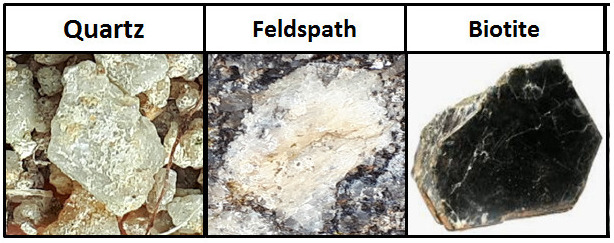
Sa texture dépend de la vitesse de refroidissement du magma à l'origine de ce granite : plus elle est lente, plus gros sont les cristaux.
Dans les cas plus extrêmes (refroidissement très lent), les plus gros cristaux (feldspath) sont pluri-centimétriques. On parle alors de phéno-cristaux et d'un granite à texture porphyroïde.
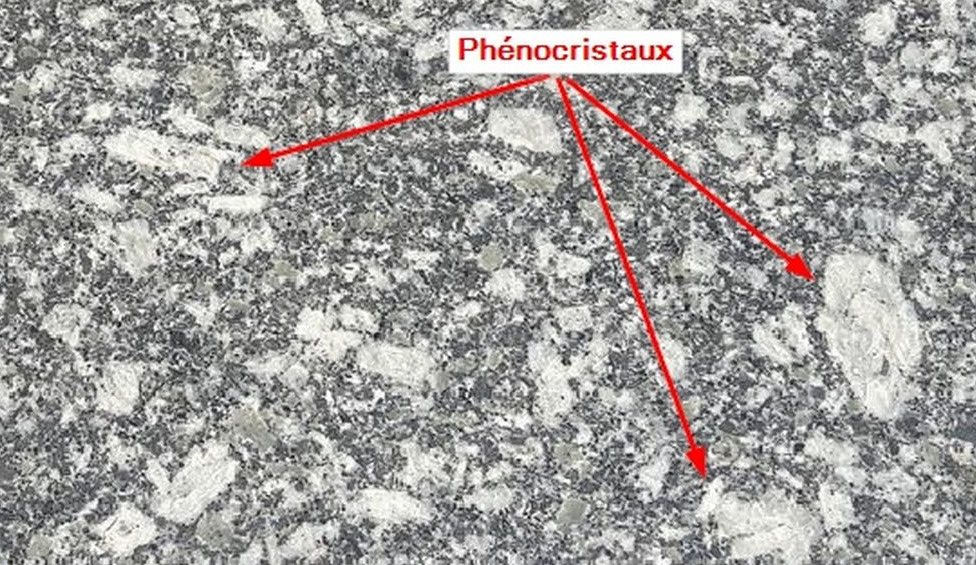
► Une enclave, des enclaves
Le granite n'est pas toujours une roche homogène et peut présenter des enclaves de nature diverses dépendant de l'environnement de formation de la roche et/ou de sa composition.
Selon le principe d'inclusion, ces enclaves sont toujours plus anciennes que la roche qui les entoure.
On distingue deux types d'enclaves.
~ Les xénolithes
Comme le précise son étymologie (du grec xenos et lithos, soit "roche étrangère"), un xénolithe est une enclave d'une roche incluse dans une roche différente dont elle n'est PAS issue.
Cette appellation s'applique aux roches magmatiques (volcaniques et plutoniques), le magma arrachant lors de son passage dans la croûte terrestre des blocs d'une roche encaissante.
Ce sont généralement des roches très différentes (péridotites, calcaires, gneiss...).
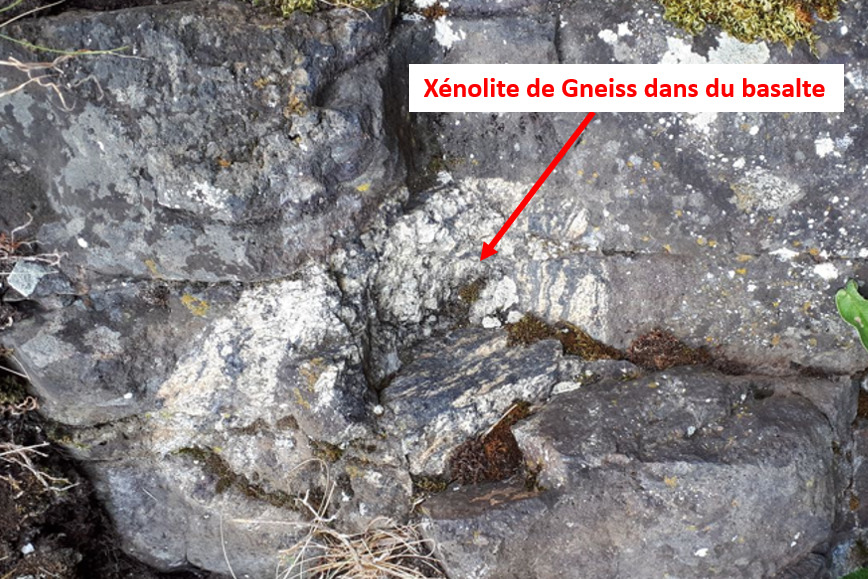
~ Les autolithes
Cette formation d'enclave est spécifique aux roches plutoniques comme le granite du fait de sa cristallisation relativement lente (par rapport à une roche volcanique).
Cette fois l'enclave a la même origine que son encaissant (même magma d'origine).
Ces autolithes sont le résultat de deux phases distinctes dans la formation du granite dues à des conditions particulières (baisse très progressive de la température) et une composition chimique originale (teneur importante en ferromagnésiens souvent issus d'une migmatite).
Les minéraux ferromagnésiens se cristallisent en premier sous la forme de biotite (mica noir).
Quand ces minéraux de biotite sont en forte concentration, ils migrent dans le liquide magmatique et se rassemblent en enclaves arrondies surmicacées (accumulation autolithique de biotite).
Puis la phase claire silicatée se cristallise autour de ces enclaves pour former une roche encaissante granitique claire comportant elle-même une proportion plus importante de biotite.
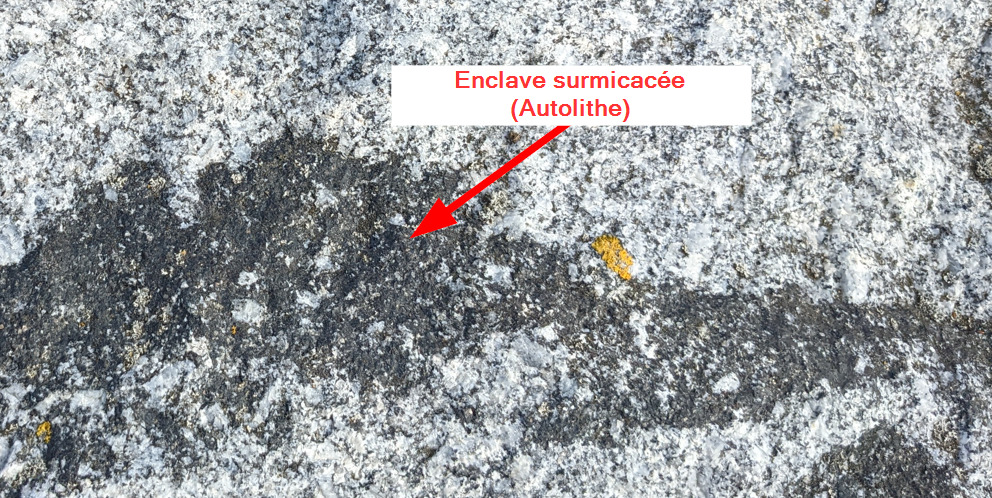
How, by studying a block of rock, can we trace its conditions of formation?
This is what we are going to see at Le Collet on a granite formation.
► Reminder on granite, a QFM rock
A granite commonly has a majority chemical composition of 3 minerals which can be summarized in QFM:
- Q for Quartz: translucent sometimes transparent, this mineral is gray without facet.
- F like Feldspar: whitish or pink, this mineral is opaque and often twinned.
- M like Mica: often black (biotite), this mineral comes in fine shiny glitter.
Its texture depends on the cooling speed of the magma at the origin of this granite: the slower it is, the bigger the crystals.
In more extreme cases (very slow cooling), the largest crystals (feldspar) are several centimeters. We then speak of phenocrysts and a granite with a porphyroid texture.
► Enclaves ? What is it ?
Granite is not always a homogeneous rock and can present enclaves of various kinds depending on the environment in which the rock was formed and/or its composition.
According to the principle of inclusion, these enclaves are always older than the rock that surrounds them.
There are two types of enclaves.
~ Xenoliths
As its etymology specifies (from the Greek xenos and lithos, meaning "foreign rock"), a xenolith is an enclave of a rock included in a different rock from which it did NOT come.
This name applies to magmatic rocks (volcanic and plutonic), the magma tearing during its passage through the earth's crust blocks of surrounding rock.
They are generally very different rocks (peridotites, limestones, gneiss...).
~ Autoliths
This enclave formation is specific to plutonic rocks such as granite because of its relatively slow crystallization (compared to volcanic rock).
This time the enclave has the same origin as its host (same original magma).
These autoliths are the result of two distinct phases in the formation of the granite due to specific conditions (very gradual drop in temperature) and an original chemical composition (high content of ferromagnesians often derived from migmatite).
Ferromagnesian minerals first crystallize as biotite (black mica).
When these biotite minerals are in high concentration, they migrate in the magmatic liquid and gather in rounded surmicaceous enclaves (autolithic accumulation of biotite).
Then the clear silicate phase crystallizes around these enclaves to form a clear granite host rock itself comprising a greater proportion of biotite.
► Sources bibliographiques / Bibliographical sources
Les Questions / The Questions
La lecture attentive du descriptif de la cache, ainsi qu'une observation des éléments de terrain et un peu de déduction sont normalement suffisants pour répondre aux questions de cette EarthCache.
A careful reading of the description of the cache, as well as observation of terrain features and some deduction is usually sufficient to answer questions of this EarthCache.
Questions pour valider :"Quelles enclaves au Collet ?"
Questions to validate: "Which enclaves in Le Collet?"
Vous voici au sommet de la digue. Un bloc de granite se détache visuellement (photo WP1).
You are now at the top of the dike. A block of granite stands out visually (photo WP1).
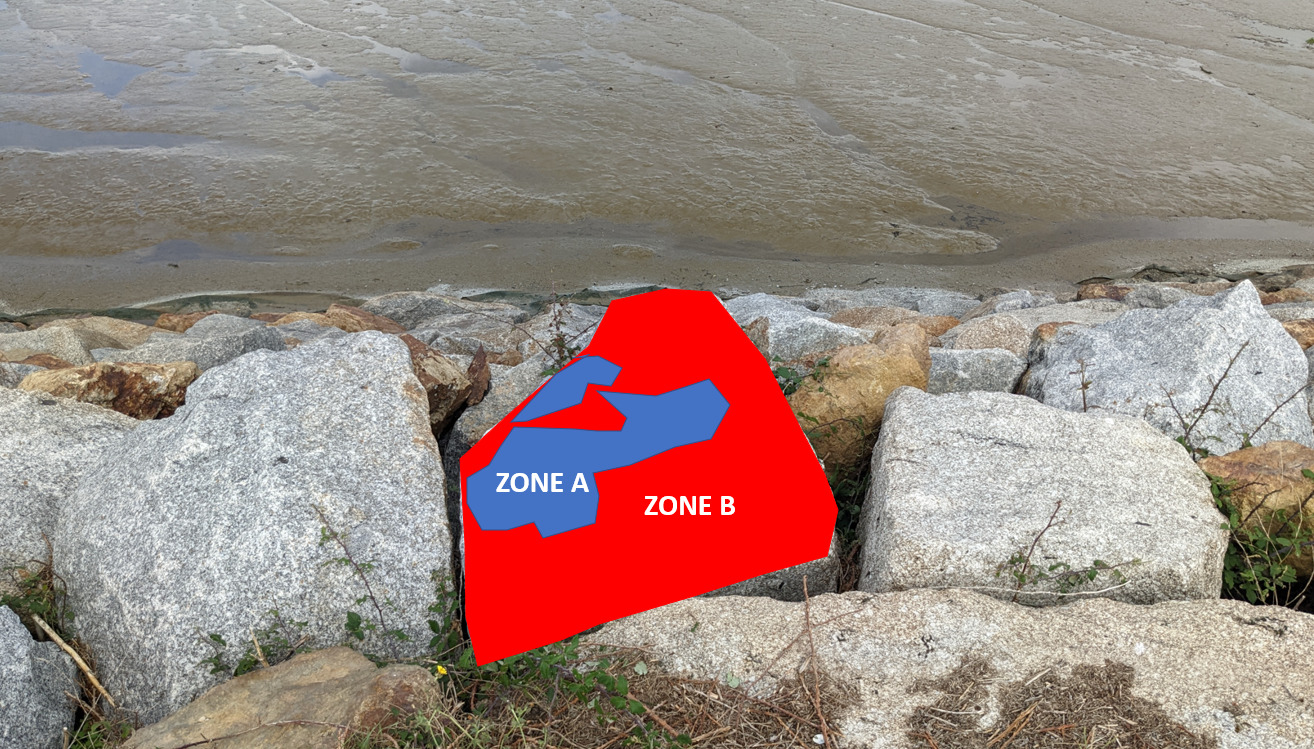
- Question 0 : Prenez une photo de vous ou d'un élément vous identifiant avec la baie de Bourgneuf en arrière-plan.
Cette photo devra au choix nous être transmise avec les réponses ou être ajoutée à votre log.
-Question 0 : Take a picture of yourself or something that identifies you with the bay of Bourgneuf in the background.
This photo must either be sent to us with the answers or added to your log.
- Question 1 : Décrivez la zone A bleue. de quelle type d'enclave s'agit-il ? Déduisez sa nature chimique et la façon dont elle est arrivée là.
- Question 1 : Describe the blue area A. what kind of enclave is it? Deduce its chemical nature and how it got there.
- Question 2 : Décrivez la zone B rouge. Déduisez en les conditions de cristallisation de ce pluton.
- Question 2 : Outline the red B area. Deduce the crystallization conditions of this pluton.
- Question 3 : Des deux zones, laquelle s'est formée en premier ? Expliquer votre raisonnement.
- Question 3 : Of the two zones, which formed first? Explain your reasoning.
Vous pouvez vous loguer sans attendre notre confirmation,
mais vous devez nous envoyer les réponses en même temps soit par mail via notre profil (
fafahakkai), soit via la messagerie geocaching.com (Message Center).
S'il y a des problèmes avec vos réponses nous vous en ferons part.
Les logs enregistrés sans réponses et la photo seront supprimés.
You can log this cache without waiting for our confirmation, but you must send us the answers at the same time, by e-mail via our profile (fafahakkai) or by the system of Message Center of geocaching.com.
If there is a problem with your answers we will notify you. The logs recorded without answers and the photo will be deleted.
Rappel concernant les « Earthcaches »: Il n'y a pas de conteneur à rechercher ni de logbook à renseigner. Il suffit de se rendre sur les lieux, de répondre aux questions ci-dessus et de nous renvoyer les réponses.
Reminder concerning "Earthcaches": there is neither a container to look for nor a logbook to sign. One need only go to the location, answer to the differents questions and send us the answers.